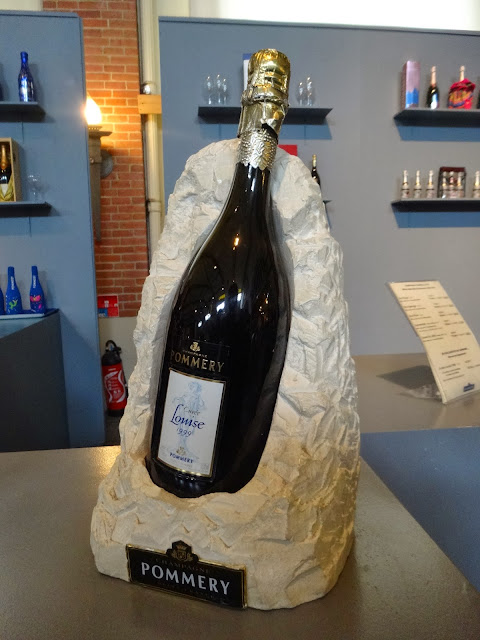Barring its price, I love everything about champagne. The delicate taste, the perfect balance of sugar and acid, the golden hue, the fineness of the bubbles and its ability to pair with any food imaginable.There's no doubt it's a magical thing.
Fully aware of the care and effort that goes into making a bottle, I included as part of my elaborate itinerary in France a detour to Reims, home of the finest producers of champagne in the world.
By law, champagne can only be made from three grape varietals - pinot noir, pinot meunière and chardonnay. Though the first two are red grapes, most champagnes have a golden-green hue because only the colorless juice from the flesh is pressed. After an initial fermentation and bottling, the wine undergoes a second fermentation within the bottle. Careful aging for a minimum of 18 months at controlled temperatures and humidity levels and the interaction between the wine and the yeast produces both the delicate flavors and the bubbles which are characteristic of champagne.
Upon first sight, Reims (pronounced Ra-'n's) appeared to be largely empty like a ghost town-- most probably because all the good stuff is underneath. What makes this place so unique is that the champagne is aged in manmade chalk-pit cellars or crayères located 30 meters below ground level. These were dug around the 4th century during the Gallo-Roman by some not-very-intelligent people who believed the porous crumbly chalk -- the same stuff you write on a blackboard with-- would make an excellent building material.
 |
| The empty streets of Reims |
 |
| Cross-section representation of the chalk-pits from the Gallo-Roman era |
Instead, what chalk is actually quite good for is aging champagne. It maintains the temperature at a constant 12 degrees and the sponge-like quality keeps the humidity level at 88 percent. Couple this with the absence of sunlight and you have the recipe for some great bubbly.
While in Reims, the only acceptable thing to do was spend the whole day touring champagne houses. I picked three that are uniquely different as well as make some damn good champagne.
First, I headed to Taittinger, one of the biggest champagne makers in the world with an annual production of about 5.5 million bottles a year! The cellars were magnificent and the glass of champagne at the end was great but the tour felt a little cold, pun intended.
 |
| The cellars of Taittinger |
So I headed to Ruinart where Sarah (who had earlier set me up with a tour in Valpolicella as well as introduced me to Davide in Alba) had hooked me up with a personalized tour. Ruinart established in 1729 is the oldest established champagne house in the world.
They are now a niche luxury brand and are very picky about where their bottles are sold or served. I don't blame them. Because the Ruinart Blanc de Blancs I tried was probably one of the finest things I've ever tasted.
 |
| Blanc de blanc being aged in the cellars at Ruinart |
 |
| Ruinart Blanc de Blancs |
My third and favorite out of the three visits was Pommery. Having descended down 116 steps into the cellars, it felt like I had traveled back in time. Pommery's tunnels and chalk pits stretch over 18 kilometers and they are as spectacular as they are elaborate. Madame Louise Pommery who built the estate in 1868 was a patron of the arts and she had sculptors carve exquisite murals into the chalk that remain in all their glory to this day.
 |
| Continuing Madame Pommery's patronage of art at Pommery |
 |
| The 116 steeps steps to the crayeres of Pommery |
 |
| Just a glimpse of Pommery's 18 kms of tunnels |
 |
| Pommery's vintage collection |
 |
| Murals carved into the chalk at Pommery |
 |
| Louise 1999 |
However, what made my visit to Pommery even more special was Margot Crepin. By some freak coincidence, my couchsurfing host in Reims also happened to be a champagne tour guide for Pommery and a really good one at that. Margot who had spent several years traveling and working in different parts of the world including India, England, Spain and Brazil not only made me feel very comfortable in Reims but showed me around one of the best champagne houses in the world!
Happy and drunk to my heart's content of champagne, I decided it was time to move on. I was headed east to the beautiful city of Strasbourg near the German border for yet another adventure in food and wine.


Nice article boss.
ReplyDeleteExquisite moon rise shot!!!! camera or iphone??
ReplyDelete